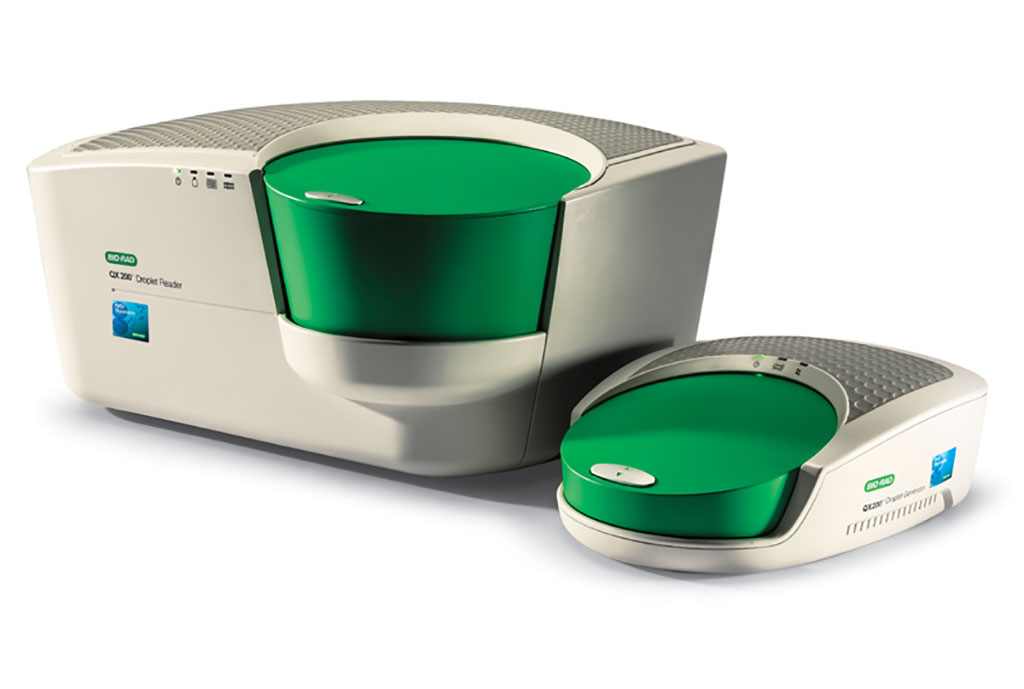Digital PCR Improves BCR-ABL1 Detection in Chronic Myeloid Leukemia
By LabMedica International staff writers
Posted on 22 Apr 2021
Specific targeting of the Bcr-Abl1 enzyme by tyrosine kinase inhibitors (TKI) revolutionized the management of chronic myeloid leukemia (CML) to the point that TKIs can offer near normal life expectancy for CML patients.Posted on 22 Apr 2021
However, some CML patients do not achieve optimal response at defined treatment time points, and others even develop TKI resistance. Therefore, molecular monitoring is crucial for clinical management of CML. Digital PCR (dPCR) offers high reproducibility, precision and increased sensitivity for rare target detection.

Image: The QX200 Droplet Digital Polymerase Chain Reaction (PCR) Systems provide ultrasensitive and absolute nucleic acid quantification. (Photo courtesy of Bio-Rad)
Medical Scientists from various disciplines at the Masaryk University (Brno, Czech Republic) performed a retrospective analysis of 70 clinical samples from chronic phase CML patients and 15 samples from healthy volunteers used as BCR-ABL1 negative controls. Reverse-transcription (RT-qPCR) quantification of BCR-ABL1 in K562 cells was performed on an Applied Biosystems 7300 Real-Time PCR System (Waltham, MA, USA). The Xpert BCR-ABL Monitor test (Cepheid, Sunnyvale, CA, USA) was used for quantification of BCR-ABL1 in clinical CML samples. All dPCR measurements were performed on the on QX200 Droplet Digital PCR System (Bio-Rad, Hercules, CA, USA).
The investigators reported that despite overall correlation of ratios, they observed significant differences in copy numbers quantification between RT-qPCR and dPCR. In the samples containing high transcript levels (10%–0.1% BCR-ABL1IS), RT-qPCR detected significantly more BCR-ABL1 copies than dPCR (P < 0.0001). Conversely, in the sample with low transcript levels (0.0032% BCR-ABL1IS), RT-qPCR quantified significantly less BCR-ABL1 copies compared to dPCR. Moreover, in all sample categories dPCR detected significantly less ABL1 copies. A total of 44 CML patients, routinely monitored by GeneXpert, were tested by dPCR. The team observed significant differences in the ratios measured by dPCR and GeneXpert in the 36 patients with low transcript levels (≤0.1% BCR-ABL1IS), which also resulted in low correlation between the methods.
The authors concluded that their study demonstrated that droplet dPCR, tested with standard EAC assays, provided a detection limit of above three BCR-ABL1 copies/sample, which corresponded to sensitivity of conventional quantitative methods. Nevertheless, dPCR categorized more than 50% of the CML patients into different MR categories compared to quantitative GeneXpert. The study was published in the May, 2021 issue of the journal Practical Laboratory Medicine.
Related Links:
Masaryk University
Applied Biosystems
Cepheid
Bio-Rad













